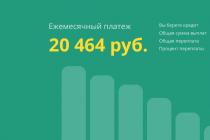The child care allowance is assigned to a woman upon completion of the post-natal leave and is paid up to one and a half years of the child. The father and other relatives who provide real care for the baby also have the right to take “children's” leave and receive benefits if insurance premiums are paid for them to the FSS. How to calculate parental leave in 2018, we will tell in this article.
Assignment of "children's" allowance
The employer assigns the allowance upon receipt of an application for parental leave and the payment of benefits for up to 1.5 years. Within 10 calendar days, the allowance must be assigned, and the first payment is made on the next payday.
"Children's" allowance is paid from the FSS. Withholding personal income tax and accrual of insurance premiums on the amount of benefits is not made.
If the child's mother returns to work before the end of her vacation, her "child" allowance will stop, but the mother's allowance will continue if she is part-time.
Period for calculating child care allowance 2018
In 2018, payments that were subject to “social insurance” contributions in case of maternity and illness in 2016-2017 are accepted for calculating benefits. Moreover, these incomes are limited by the following limits:
- for 2016 - 718,000 rubles,
- for 2017 - 755,000 rubles.
The two-year period accepted for calculation includes 730 days (731 - if the year is a leap year), minus the days of sick leave and maternity leave that fell on this time (paragraphs 3 and 3.1 of article 14 of the law of December 29, 2006 No. 255-FZ).
If maternity leave fell on the billing period, a woman has the right to ask for a replacement of years when “maternity” years are replaced by the next earlier ones. In 2018, such years may be 2014 and 2015, respectively, for the calculation the income limits in force at that time are applied:
- RUB 624,000 in 2014,
- RUB 670,000 in 2015.
An important condition: you can apply the replacement of years only at the request of the woman, if this changes the amount of the “children's” allowance upwards (clause 1, article 14 of law No. 255-FZ).
How is the allowance up to 1.5 years calculated in 2018
For those who work, the amount of benefits next year will remain the same: 40% of the average earnings of someone who takes a "children's" leave. Allowances for caring for several children are assigned to each child, in the amount not exceeding 100% of the average earnings (Article 11.2, Article 15 of the Law of May 19, 1995 No. 81-FZ).
Benefit calculation procedure:
- First, the average daily earnings are determined:
- Then the amount of the monthly allowance is calculated:
In 2018, the maximum amount of the “children's” allowance will be:
(718,000 rubles + 755,000 rubles) / 730 days x 30.4 x 40% = 24,536.57 rubles. per month.
This means that even if, as a result of calculating payments for child care, their size turns out to be higher, the allowance is assigned in an amount not exceeding 24,536.57 rubles.
Non-working mothers, and those whose average earnings are below the official minimum wage, the allowance is calculated in the minimum amount.
According to Part 1 of Art. 15 of Law No. 81-FZ, the minimum allowance is 1,500 rubles. for the first, 3000 rubles. - for the second and subsequent children. These amounts are indexed annually by the Government and amount to at least 40% of the current minimum wage.
In connection with the next increase in the minimum wage, the minimum allowance assigned from 01/01/2018 and later should be 3,795.60 rubles. (9489 rubles x 40%) for the first child and 6131.37 for the care of subsequent children. Where regional coefficients apply, they should also be applied when calculating the minimum “children's” allowance.
An example of calculating the "child" allowance up to 1.5 years
Employee Lisitsyna's parental leave for a child up to 1.5 years old begins in January 2018. Her income subject to social insurance contributions in 2016 was 695,000 rubles, in 2017 - 468,000 rubles. In 2016, Lisitsyna spent 10 days on sick leave, and in 2017 - 125 days on pre- and post-natal leave. The replacement of years was not applied, since in previous years the woman did not work.
First, we calculate the average daily earnings of an employee. Since 2016 was a leap year, 731 days are applicable for the calculation:
(695,000 rubles + 468,000 rubles) / (731 days - 10 days - 125 days) = 1,163,000 rubles / 596 days = 1951.34 rubles
Lisitsyna's allowance for a child is 40% of her average salary:
1951.34 rub. x 30.4 days x 40% = 23,728.29 rubles. per month.
The result obtained does not exceed the maximum allowance, personal income tax is not withheld from it, which means that Lisitsyna will receive 23,728.29 rubles. monthly until the age of a year and a half of the child.
Holiday to care for the child. Calculation of vacation pay, examples.
In colloquial speech, a decree is called all the time that an employee does not work in connection with preparing for the birth of a child and caring for him in the first months of life. The Labor Code does not mention this general concept. The law divides the time of the decree into two periods: maternity leave, as well as parental leave.
- Maternity leave
- Holiday to care for the child
Maternity leave
In its form, it is rather not a vacation, but a sick leave, since a sick leave is issued for it.
In this sheet, the gynecologist of the antenatal clinic, where the pregnant woman is observed, sets the start and end dates for the sick leave. It starts from the thirtieth obstetric week of pregnancy and generally lasts 140 days: 70 days before the expected birth and 70 days after. In some situations, which are also recorded by doctors, vacation periods are increased.
Medicine, with all its modern technologies, is unable to guess the exact date of birth. The doctor indicates only an approximate time. In fact, children are most often born with a deviation of several days and even weeks before or after the declared time. At the same time, sick leave periods are not recalculated.
Example. The employee's maternity leave start date is May 9, 2017. End - September 26 (after 140 days). Estimated due date is July 18th. In fact, the employee gave birth on June 30. That is, before giving birth, she spent 52 days, and her postpartum period was 88 days. The end date of the vacation remains the same - September 26th.
An employee who is going on maternity leave is entitled to a one-time allowance. The employer pays it in one amount based on the number of days on the sick leave.
The allowance is paid in the amount of 100% of the average daily earnings, therefore, with rough rounding, it is sometimes said that the expectant mother receives four salaries at once. This is true only with a fully official employment.
The expectant mother needs to bring a package of documents to the personnel department:
- Certificate of incapacity for work. It is issued in a medical institution a few days before the moment when it is time to go on maternity leave
- Help with the calculation of average earnings from the previous place (places) of work, if there were such in the past and the year before last
- Statement to the CEO of the organization
- Early registration information up to the 12th week of pregnancy. It is not a required document. But if the employee really went to the doctor early, she will receive an additional payment. Thus, the state encourages early registration of pregnant women, which allows you to better monitor their health and the condition of the baby.
Holiday to care for the child
With the safe birth of a child, maternity leave smoothly turns into parental leave. According to the law, a young mother can stay in it until the child is 3 years old. For example, if the child was born on September 26, 2017, the employee must return to work on September 27, 2020.
Many mothers sit with a child only up to 1.5 years. This is due to the fact that the state (through the employer) pays cash benefits only until the child reaches the age of eighteen months.
After this date, the payment of benefits ceases, but the opportunity to deal only with the child until his third year remains. Young mothers use it if they have such a desire and the family has financial opportunities for this.
In order for the employer to have a basis to accrue child care allowance, the employee must come to work with the following documents:
- Birth certificate of the child (a copy is made from it and the original is returned to the employee)
- Application addressed to the General Director of the company (the application form is drawn up in free form, your sample is available within the organization)
- Certificate stating that such benefits will not be paid to the second parent (the spouse must take this certificate from his place of work or from Social Security if he is not officially employed)
- Copy of applicant's passport
Any person who actually takes care of the child can go on such leave. For example, it may be the father of the child or one of the relatives. It is important that he actually stops working, otherwise the payment of benefits will become illegal.
The employee also applies for a one-time payment for the birth of a child. Since February 2017, it has grown and now stands at 16,350.33 rubles.
How to calculate maternity payments
The maternity benefit is 100% of the average daily earnings and is paid in one large amount before the start of the decree. To calculate the amount of the benefit, several steps must be taken.
- Calculation period definition. To calculate the due payments, the previous two years before the decree are taken into account. They can be replaced by any other two years, if at that time the employee was already on maternity leave
- Collection of missing data on wages for the billing period. In the ideal case, the employee worked for the same employer for the previous two years, then the necessary information will be at hand. If a woman has worked for a shorter period, she needs to submit to the employer from previous places of work a certificate in form 182, approved by the Order of the Ministry of Labor
If the employee did not work for some months from this period, the average earnings for such months are equal to the minimum wage in force at the time of the insured event.
As of May 2017, the federal minimum wage is 7,500 rubles.
This is a relatively small amount for maternity leave. Therefore, many women, when planning a pregnancy, try to work continuously for two years in a row in order to receive more benefits.
According to the minimum wage, all 24 months of the billing period are calculated if the employee's work experience for these two years is less than 6 months.
- Definition of biennial earnings. To calculate the final value, all accrued wages for the billing period (before deducting income tax) are summed up by months. It is very easy to determine whether one or another charge should be included in the amount. If the employer paid insurance premiums from it to the budget, the accrual is taken into account. If not, it is ignored.
Thus, when summing up, the amounts paid to the employee during her temporary disability, as well as the amounts paid to her when she was released from work with the preservation of wages, are deducted. The employer does not make social contributions from these incomes.
- Comparison of annual amounts received against the marginal contribution base. There are limits on the maximum annual earnings for calculating maternity benefits.
Data for 2017 will become relevant only after the onset of 2018, since in relation to it this year will become one of the two years of the calculation period.
If the total annual salary of an employee is above the specified limit, her salary during the calculation is indicated in the amount of the limit.
Minimum limits also exist. If in a certain period the monthly income of an employee was less than the minimum wage, then her monthly income for this time is conditionally equated to the minimum wage.
Example. The employee went on maternity leave in 2017. Her annual earnings for 2016 amounted to 700 thousand, for 2015 - also 700 thousand. To calculate the allowance, earnings of 700 thousand in 2016 and only 670 thousand in 2015 will be taken into account.
- Calculation of the average daily earnings. The formula is used for calculations.
Average earnings \u003d (Earnings for two billing years in total) / (sum of days for these years minus sick days).
Example. The employee's earnings for 2016 and 2015, excluding sick leave, amounted to 600 thousand rubles. She was on sick leave for a total of 30 days. In fact, in two years she worked: 731 days + 730 days - 30 days = 1,431 days. Her average daily earnings are: 600 thousand / 1431 days = 419 rubles. The number of days in a normal year is 730. In a leap year, 731 (as in the case of 2016).
As can be seen from the example, if an employee was ill last year and the year before, this does not significantly affect maternity payments. Neither the payment of the sick leave, nor the sick days themselves are simply not included in the calculations.
- Determining the amount of the allowance. To do this, the average daily earnings are multiplied by the number of days of maternity leave (140, 156 or 194 days).
Let's continue the example from the previous paragraph. We multiply the average earnings of 419 rubles by 140 days. The allowance will amount to 58,660 rubles.
The childcare allowance is 40% of the employee's average daily earnings and is paid monthly on paydays. An important rule: if a new mother resumes full-time work, the payment of benefits stops. Only part-time or home-based work is possible.
Maternity payments are not subject to income tax, the employer also does not pay insurance premiums from them. Therefore, this period is not taken into account in the calculations.
Example. Until 2015, the employee worked 730 days (without sick leave) and her accrued salary is 600 thousand rubles. In 2016, she worked for nine months, and since October she went on maternity leave, she was credited (excluding benefits) 550 thousand rubles. Number of days taken into account in 2016: 731 minus 92 days (number of days from October to December 2016) = 639 days. Average daily earnings: (600 thousand + 550 thousand) / (639 days + 730 days) = 1150 thousand / 1369 = 840 rubles.
Total monthly allowance to be paid in 2017: 840 rubles * 30.4 days (average number of days in a month) * 40% = 10,214 rubles
Manual calculations are important for a better understanding of where certain amounts come from. Now you don’t need to think about how to calculate maternity pay - it’s most convenient to use an online calculator.
Who pays maternity leave - the employer or the state
The procedure takes place in several stages: It is the employer who is obliged to calculate and pay maternity benefits to his employee. This procedure is established by law No. 255-FZ. But at the same time, the employer does not spend his own money, since after a while the Social Insurance Fund of Russia reimburses him for all costs.
- The employee provides the employer with a sick leave for pregnancy and childbirth. If we are talking about applying for benefits for a born child, then the employee writes an application for parental leave
- Based on the information received, the accountant calculates the amount of payment
- The employer pays benefits. If before the decree an employee received a salary on a bank card, then she will receive the money transferred by the employer in the same way. In this case, the accrual of funds is carried out on the next day of the salary payment, established in the organization.
- The employer submits a report and other documents to the FSS
- The FSS checks the documents for compliance and authenticity and reimburses the money to the employer
Social Security checks all data in the most thorough way. On their part, it is possible to recalculate or even refuse to refund funds.
The following features are of concern:
- The position of the employee does not correspond to education (for example, if the chief accountant has only completed cooking courses)
- Disproportionately high wages for such a position (400 thousand rubles for the position of a junior lawyer)
- The position appeared in the company simultaneously with the arrival of this employee (this happens when the company expands and invites a specialist, but if there are other suspicious points, this can serve as an additional source of doubt)
- A significant increase in salary before going on maternity leave (an atypical occurrence in itself, which suggests collusion)
- The employment of the employee took place almost before going on maternity leave, especially if before that she had not worked for a long time (and in this case, collusion with the employer can be suspected)
There are cases when cunning girls forged certificates in order to get a bigger payout. The FSS will not pay blindly, and sooner or later the truth will come out. The tricksters are forced to return the funds paid.
If the employing organization is liquidated or it has insufficient funds in its current account, or the owners of the company have disappeared, the state pays benefits on its own. To do this, you must come to the local FSS with supporting documents. After the procedure for checking documents, the Fund will independently make calculations and pay the due money.
What can an employee do if the employer does not pay maternity leave, does not pay in full, or delays
- It is necessary to carefully read the employment contract and find the amount of official wages. When calculating maternity pay, only official payments (salary, bonuses, allowances) that have passed through the accounting department and from which the employer has paid insurance premiums for the employee are taken into account. If an employee received some part of the funds "in an envelope" - contributions to the FSS were not paid from them, and they are not taken into account in any way.
- If the company is “white”, but the actual payments do not match the calculations of the employee, it is best for her to seek clarification directly from the accountant who calculated the maternity. There are many subtleties in these calculations that could be missed by the worker through ignorance.
- Benefits are not automatically calculated, but only upon application. If a woman has not yet compiled it, she needs to come to work, write an application and submit the necessary documents. It is also possible that there was an error in the current account numbers, and it is enough just to clarify the misunderstanding.
- If there is no mistake and the employer deliberately evades payments, the employee can file a complaint with the FSS of Russia at the place of registration of the employer. The Fund has its own leverage on unscrupulous employers. If he could not help, the employee can write a statement to the Prosecutor's Office. It can be submitted in person or by letter, and there is also the opportunity to leave a complaint on the website of the Prosecutor General's Office.
- Another option is to go to court. After the court makes a decision in favor of the employee, bailiffs are involved in collecting money from the employer.
What can an employee do after maternity leave ends?
After this period, the employee has several ways:
- Return to work immediately
- Temporarily take paid leave. Part of the vacation could not be used before going on maternity leave. In addition, parental leave is legally the time for which the length of service is accrued. Thus, vacation is also accumulated during this time
- Temporarily take unpaid leave. This option is only possible upon agreement with the employer.
Example. A woman, while on leave to care for her first child, becomes pregnant with her second child. There is still some time left for her to go on maternity leave for her second child, and she should already go to work, since the first child is already 3 years old. The woman does not want to go to work for this period. An employer cannot fire a pregnant woman. Then leave without pay is an acceptable way out.
- Quit. Upon dismissal, the employer is obliged to compensate the employee for her unused vacation.
Changes in maternity payments in 2017
As seen in the previous paragraphs, in some cases, to calculate maternity payments, the employer resorts to the current value of the minimum wage (minimum wage).
As of May 2017, two pieces of news are being actively discussed:
- From July 1, 2017, the minimum wage will be increased by 300 rubles. This means that for a fully worked month, an employee cannot receive a salary of less than 7,800 rubles. If the local minimum wage of a constituent entity of the Russian Federation is below this value, companies should focus on the federal indicator. If higher, they can be guided by the local value.
- Until May 20, 2017, a draft law on raising the minimum wage to the subsistence level of the able-bodied population should be prepared. Dmitry Medvedev gave relevant instructions to the Ministry of Labour, the Ministry of Finance and the Ministry of Economy. Today, the living wage in Russia is 9,691 rubles. Also, the head of the Ministry of Labor Maxim Topilin assured that the minimum wage will be the same for the whole country - differentiation by region will become a thing of the past.
Also, during his April speech to the State Duma, the prime minister stressed that the government is increasing the responsibility of employers: “Those who delay money are fined. Now we are preparing amendments to the legislation to better protect the rights of working people.”
This issue also includes cases when employers, for whatever reason, delay maternity payments to employees.
According to Federal Law No. 255-FZ, certain payments are due to expectant mothers. This is, first of all, payment for sick leave (the last weeks of pregnancy, childbirth, the period after childbirth). From the article you will learn who is entitled to receive this benefit, officially called pregnancy and childbirth, and how to calculate the amount of maternity leave in 2017.
What is maternity?
The maternity allowance is a one-time allowance for the birth of a child.
When calculating maternity leave, the number of days on sick leave is taken into account, the number of which depends on the following circumstances:
- If born 1 baby , then the total number of days on sick leave is 140 (the formula is simple: 70 days before birth, 70 days after birth ).
- If the birth of the baby was associated with some complications, the number of days on the sick leave increases by 16 .
- If the family has a large replenishment - 2 or more babies , then the number of sick days is even greater: 84 days before childbirth, and after childbirth - 110 days .
Who can receive maternity allowance in 2017 - the maximum and minimum amount of maternity allowance payments
- Working pregnant women subject to compulsory health insurance.
- Unemployed pregnant women who must be registered with the employment service in the area of residence.
- Women who work as self-employed. In this case, it is necessary that during the last six months (at least) contributions to the Social Insurance Fund were deducted.
- Students of educational institutions studying full-time(regardless of the budget, they are trained or paid).
What determines the amount of maternity leave?
As for the amount of maternity leave, when calculating it, it takes into account average earnings of a woman in the last two years. For working women, the average salary is taken, for full-time students - a scholarship, for women who work under a contract in the ranks of the Armed Forces of the Russian Federation, as well as in institutions of the penitentiary system, at customs - the amount of monetary allowance.
Since January 1, 2016, changes have been made to the minimum and maximum amounts of benefits:
- minimum - 28 555,80 rubles
- maximum - 248 164 rubles
According to the law, personal income tax is not withheld from maternity benefits.
Making a maternity allowance in 2017: what list of documents should be collected by working, unemployed, students to receive payments
In order to apply for and then receive maternity benefits, you must prepare package of the following documents:
- statement on behalf of a woman for benefits
- sick leave who provides women's consultation
Where should pregnant women submit documents for maternity payments?
Working women submit these documents to the employer, students of educational institutions - to the dean's office. Unemployed apply to social services at the place of residence.
Calculation of maternity leave in 2017 - how to independently calculate the amount of benefits on maternity leave
- Easiest calculate maternity pay for a permanently working woman, since in this case her average earnings for the last two years are taken into account. Therefore, to calculate benefits in 2017, the average salary for 2015 and 2016 is taken. At the same time, it should be taken into account that in addition to wages, all kinds of bonuses, payments, allowances and coefficients, material assistance, if they took place and were fixed, are taken into account for accrual. The calculation does not include sick leave, other maternity leave. It is imperative to take into account income from other employers, for which it is necessary to submit a certificate of average earnings to the accounting department.
- If the woman was on parental leave or on maternity leave previous 2 years (even if it is one or two days per year), then it is possible to replace this year with the year preceding it (replacement is made upon application).
- If a woman before going on maternity leave worked in two organizations or two enterprises, then documents for benefits are submitted only in one place. In this case, it will be necessary to provide a certificate that other employers do not pay maternity benefits.
It is important to know that the average earnings also have their limits for calculating maternity benefits. So, the amount of the benefit cannot be more than the indicator, which is determined by dividing by 730 the sum of the limit values \u200b\u200bof the base for calculating insurance premiums. 730 - the total number of days that a woman worked in two years (if the year is a leap year, then 731). But this is only if she did not have sick days, vacations and other days from which deductions to extra-budgetary funds for compulsory types of insurance are not taken.
What to do and how to correctly calculate maternity pay if the work experience in the last place is less than 2 years?
Situations where the work experience of a pregnant woman at her last job is less than 2 years are not uncommon, and women must know all the details and subtleties in order to receive benefits.
How to correctly calculate maternity pay if the work experience in the last place is less than 2 years?
According to existing provisions, the amount of maternity allowance should not be less than the minimum wage.
What is the base limit?
In order to correctly calculate the amount of the benefit, it is also necessary to take into account other indicators such as the marginal value of the base used to calculate insurance premiums. This indicator is not constant, it changes all the time and is different for each year. For the years preceding 2016, it is equal to:
- 2013 - 568,000 rubles
- 2014 - 624,000 rubles
- 2015 - 670,000 rubles
Why is this indicator needed? When calculating the allowance, the woman's income is taken into account, but the total amount of income for a certain year should not exceed the maximum amount of the base for that year.
As an example: if a woman in 2013 had a total income of 570,000 rubles, then all calculations will be made based on the amount of 568,000 (the limit for 2013).
How to calculate maternity leave in 3 common situations?
Sample calculation of maternity leave in 2017
Let's say that citizen Zavyalova's maternity leave begins in April 2017. Before the decree, she worked constantly, so two years are taken into account - 2015 and 2016. At the same time, in 2015 she had two sick leaves of 7 and 10 days, in total - 17 days. Income for 2015 amounted to 340 thousand rubles, for 2016 - 480 thousand. Limit values by years are not exceeded. The number of days for two years is 730. Sick days are subtracted, which gives a total of 713 days.
Calculation of the average daily wage:
340 + 480 / 713 = 1,150 rubles
Calculation of the size of maternity:
1150 x 140 days of decree = 161,000 rubles.
Documents to be submitted to the FSS for calculating maternity IP
First of all, in order to receive pregnancy and childbirth benefits for a female IP, it is necessary:
- Register as a voluntary insured. To do this, you must submit an application to the FSS (there is an established form), as well as a copy of the IP passport. Within five days, the Fund must register the insured, and then notify him of this procedure.
- Pay insurance premiums. If a woman is going on maternity leave in 2017, then insurance premiums must be paid for 2016. The amount of contributions is calculated based on the formula: Minimum wage x FSS contribution rate x 12 months. The deduction rate is 2.9%.
To receive maternity allowance, the following documents are provided to the FSS:
- application from IP in any form to receive benefits;
- sick leave, received in the antenatal clinic.
The allowance is calculated based on the size of the minimum wage.
The rules for calculating maternity and child benefits are of interest to both accountants and expectant mothers. We will talk about the changes in 2017 and teach you how to use an online calculator to calculate the amounts of these payments.
How to use the maternity and child allowance calculator?
The maternity and child allowance calculator from the Kontur.Accounting service will help you easily calculate the amount of payments. The calculator is available for free and without registration. Making the calculation is very simple:
- On the "Initial data" tab, select the desired allowance, enter data from the sick leave or information about the child and the duration of the vacation.
- On the "Pivot Table" tab, enter information about the employee's earnings for the last 2 years (or previous years when replacing years). If a district coefficient is applied, check the box in the required field. If the employee works part-time, indicate this.
- On the tab "Results" you will find out the amount of sick leave.
Calculations take a couple of minutes. If you are an employee, please add our calculator to your Bookmarks so you can calculate benefits if needed. If you are an accountant, appreciate the convenience of working with a calculator. Kontur.Accounting has many other convenient tools for keeping records and payroll.
Free calculators for sick, maternity, vacation pay - these are our widgets in the public domain. If you want to quickly calculate salaries, easily keep records and send reports via the Internet, register in the online service Kontur.Accounting. The first 30 days of operation are free for all new users.
The main changes in the calculation of benefits in 2017
New MOT. At the beginning of 2017, the minimum wage is 7,500 rubles. Then the minimum daily earnings: 7,500 rubles * 24 months / 730 days = 246.58 rubles.
Settlement period. If the decree begins in 2017, then the previous two years, 2015-2016, are taken to calculate benefits. There is a maximum earnings from which benefits can be accrued: in 2015 it is equal to 670,000 rubles, in 2016 - 718,000 rubles. Then the maximum daily earnings for calculating benefits is: (670,000 rubles + 718,000 rubles) / 730 days = 1,901.37 rubles.
Change years. An employee can write an application to replace two settlement years when it is beneficial for her. For example, in 2015-2016, an employee went on maternity leave and parental leave, and in 2017 she went on maternity leave with her youngest. This means that in 2015-2016 she did not have earnings, so it would be more profitable to calculate the allowance from 2013-2014. The Ministry of Labor explained that the allowance can be calculated for the two nearest previous years - and not for any others: if the employee left the previous decree in 2015-2016 , then you can make a replacement only for 2013-2014.
The maximum amount of maternity. In 2017, with a decree duration of 140 days, the amount of maternity leave cannot exceed 1,901.37 rubles * 140 days = 266,191.80 rubles. With a longer or shorter decree, the amount changes proportionally.
Maximum monthly child allowance: 1,901.37 * 30.4 days * 40% = 23,120.66 rubles.
Minimum monthly child allowance. When caring for the first child, the allowance should not be less than 3,000 rubles, for the second or third child - not less than 5,817.24 rubles.
Maternity allowance in 2017
In 2017, the old rules for calculating maternity leave work. The decree comes no earlier than the start of the sick leave for pregnancy and childbirth, but its first day is determined by the application of the expectant mother. An employee can go on maternity leave from the very first day of sick leave, or she can do it later.
To calculate the allowance, we take the employee's income for the previous two years. The salary for calculation is taken in full, with personal income tax. For example, if a woman goes on maternity leave on December 28, 2016, then the allowance will be formed based on the income of 2014-2015. If the decree begins in January 2017, then the allowance is calculated for 2015-2016.
Income for the year for calculating benefits should not exceed the maximum value of the base for paying contributions to the FSS:
- for 2013 - this is 568 thousand rubles;
- for 2014 - 624 thousand rubles;
- for 2015 - 670 thousand rubles;
- for 2016 - 718 thousand rubles.
The maximum daily earnings in 2017 is, as indicated above, 1901.37 rubles.
The minimum daily wage when calculating maternity pay follows from the minimum wage, as we already wrote. At the beginning of 2017, the minimum wage is 7,500 rubles, and the minimum daily wage is 7,500 * 24 / 730 = 246.58 rubles.
Maternity allowance is received not only by consanguineous, but also by adoptive parents who have adopted a baby under the age of 70 days. And then the allowance is accrued from the first day of adoption until the age of the child is 70 days.
Example. An employee goes on maternity leave in early 2017.
Orlova Maria Yurievna has been working at Rada LLC since March 2014. In early December 2016, she was given a maternity leave for 140 days from December 12. She wrote an application for maternity leave from January 1, 2017 and continued to work until the end of December.
The expectant mother goes on maternity leave in 2017, which means that incomes of 2015-2016 are taken to calculate maternity. During this period, the woman was ill for 33 days. Her earnings for 2015 amounted to 690,000 rubles, for 2016 - 730,000 rubles. Both of these amounts are more than the established limits, so the amount of daily earnings will be calculated as follows:
(670,000 + 718,000) / (730 - 33 days) = 1991.39 rubles.
But this amount is also more than the allowable daily limit, which means that the maximum allowable amount - 1,901.37 rubles - will be used in the calculations. Maria went on maternity leave 20 days later than she could have. So she uses 140 - 20 = 120 vacation days. And then the amount of maternity will be:
1,901.37 rubles * 120 days = 228,164.40 rubles.
For December 2016, Maria will receive her regular salary.
Monthly child care allowance: calculation of child allowance in 2017
The settlement period for child benefit is also the two previous years before the start of parental leave. Similarly, to calculate benefits, income for the year must not exceed the allowable limits, and daily earnings must not exceed 1,901.37 rubles. The monthly allowance is calculated by multiplying daily earnings by 30.4 days, then 40% is taken from the amount received for any length of service of the employee.
We mentioned the minimum monthly allowance above: it is 3,000 rubles for the first child and 5,817.24 for subsequent ones.
Example. An employee goes on maternity leave in 2017.
Vorobyeva Anna Igorevna goes on maternity leave from June 16, 2017. Before that, she was on maternity leave and parental leave from February 2015 to November 2016. According to the application for the replacement of years, the calculation period was 2013-2014. At this time, Anna was ill for 28 days. For 2013, her earnings amounted to 520,000 rubles (this is less than the limit of 568,000 rubles), and for 2014 - 595,000 rubles (also less than the limit of 624,000 rubles). Let's calculate the average daily earnings:
(520,000 + 595,000 rubles) / (730 - 28 days) = 1,588.32 rubles.
The monthly allowance will be:
1,588.32 rubles * 30.4 days * 40% = 19,313.96 rubles.
If a woman works under an employment contract in several enterprises, then she can receive benefits at each workplace. And one more nuance: maternity allowance is only for the mother of the child, but parental leave with a monthly allowance can also be used by the father, grandmother or other relative who will take care of the baby. This leave and allowance are received not only by biological parents, but also by the adoptive parents of a child under the age of 1.5 years.
The online service Kontur.Accounting will help you easily calculate maternity and child benefits for employees. The service has many other convenient tools that facilitate the work of an accountant. Get acquainted with the possibilities of the service for free for 30 days, keep records, pay salaries and send reports with us.
Based on materials: kakzarabativat.ru, baragozik.ru, b-kontur.ru
In contact with
Classmates
Last updated 01/31/2020Reading time: 10 min.
Only the maximum and minimum amounts of compensation change annually in the calculation of maternity pay. At the same time, the basic algorithm and principles remain the same.
The article is relevant for calculating maternity leave in 2019 and 2020.
- No. 81-FZ "On state benefits to citizens with children";
- Federal Law No. 255-FZ of December 29, 2006 “On the Provision of Benefits for Temporary Disability, Pregnancy and Childbirth of Citizens Subject to Compulsory Social Insurance”
The unemployed and self-employed receive a minimum care allowance.
According to the legislation, periods such as pregnancy and childbirth, as well as childcare up to one and a half years, are considered insurance for working women. Part of the income that a woman received in the form of a salary is lost when a child is born. The state partially compensates their losses to mothers in the form of payments:
How maternity payments are calculated
The amount of maternity benefits depends on the salary of the employee for the full two years before the birth. For example, if a woman goes on maternity or parental leave in 2020, 2018 and 2019 are taken into account.
To determine the amount of benefits, calculate the average daily earnings of a woman for 2 years. To do this, the sum of all wages is divided by 730 (the number of days).
For example, the average salary of an employee is 36,000 rubles. Her average daily earnings are as follows:
36,000 × 24: 730 = 1183.56 rubles
This calculation is standard. It should be taken into account that:
- the number of days for 2 years will be 730 in general cases, if one of the years taken into account is a leap year, the number of days will be 731, and, accordingly, 732 days if both years were leap years;
- average earnings should not be less than the minimum;
- if the employee has a total work experience of less than 6 months, the allowance is calculated from the established minimum wage;
- in regions where wages are calculated using, it is included in the minimum benefit.
For calculations, information on earnings for the past two years is accepted, for which insurance premiums were charged to the FSS. If an employee worked for only 1 year, one and a half or a month out of two settlement years, it doesn’t matter, all days are taken into account anyway.
What payments are not included in the calculation of maternity:
- periods of illness paid on sick leave;
- exemption from work in connection with the need to care for a disabled child, if it was paid;
- period of sick leave for pregnancy and childbirth;
- parental leave, if it fell on the relevant dates and other periods.
The procedure for calculating the allowance for BiR
The specific amount of the B&R benefit is determined by the number of days on vacation. Usually it is 140 days, but there are exceptions:
| Base | Days before delivery | days after | Total number of days |
| Pregnancy and childbirth without complications | 70 | 70 | 140 |
| Multiple pregnancy (twins, triplets and more) | 110 | 194 | |
| Childbirth with complications | 70 | 86 | 156 |
| Adoption of a child under 3 months | - | 70 since his birth | individually |
| Adoption of 2 or more children | - | 110 | individually |
The size of the maternity allowance is 100% of the average salary. The rule has been in effect since 2011. The average daily earnings are multiplied by 140, 156 or 194 - the number of days indicated in the sick leave. For example, the average salary of an employee is 43 thousand rubles. She's going on vacation expecting twins. Her allowance is calculated as follows:
43,000 × 24: 730 × 194, or 1,032,000: 730 × 194 = 274,257 rubles
The amount received is the money that a woman receives on sick leave for pregnancy and childbirth with twins.
If a woman for the previous 2 years prior to her vacation in the BiR did not have earnings or it was below the minimum wage, then her average earnings for calculating benefits are taken equal to the minimum wage set on the day the vacation begins.
Calculation of care payments up to one and a half years
The monthly child care insurance benefit in most cases is 40% of the average monthly salary. Calculation formula: average earnings are multiplied by 30.4, which corresponds to the average number of days in months, then by a factor of 0.4 (this is 40%).
For example, a woman received an average of 25,000 rubles a month. We calculate the allowance according to the formula:
(25,000 × 24): 730 × 30.4 × 0.4, or 600,000: 730 × 30.4 × 0.4 = 9994.52 rubles.
Exception: mothers in public service. All periods when a woman was sick are paid to her at a rate of 100%. They are fully included in the calculations. However, their income is not subject to insurance premiums. The rule of law applies to female contract employees and mothers and fathers who are employees:
- penitentiary system;
- the police;
- customs services.
Mothers in these services receive the maximum guaranteed allowance. In 2018, it is 13,109 rubles. The increase in this amount by regional coefficients is taken into account.
If a woman has worked for several employers who made insurance contributions, she can apply for benefits for several jobs. On hands she will receive money on one of them.
Minimum and maximum benefit
The minimum amount of maternity benefit is tied to the minimum wage.
The maximum amount of payments is calculated based on insurance premiums for previous years.
- For 2018, the maximum insurance base is 815,000 rubles;
- 2017 - 755,000 rubles;
- 2016 - 718,000 rubles;
- 2015 - 670,000 rubles;
- 2014 - 624,000 rubles.
In 2019, the size of the insurance base is 865,000 rubles.
Unless otherwise indicated by the woman, the insurance base for previous years is used. The maximum payouts in 2019 are:
- RUB 301,095.20 for 140 days of vacation;
- RUB 335,506.08 for 156 days;
- RUB 417,231.92 for 194 days.
The minimum amount of child care allowance up to 1.5 years in 2019:
- 4,512 rubles for the first child;
- 6,554.89 rubles for the second and subsequent children.
The maximum allowance is 26,152.27 rubles.
If a woman simultaneously takes care of two, three or more children who are under 1.5 years old, the benefits are summed up, but do not exceed 100% of average earnings.
Maternity benefits are paid by the employer, but the woman receives full compensation from the FSS. In regions where the pilot program "" operates - the FSS pays. The payment is not subject to personal income tax and insurance premiums.
Replacement of the year when calculating maternity
Before the next pregnancy, a woman may already be on parental leave. To calculate maternity benefits, she has the right to replace the previous 1 or 2 years with others if the benefit increases in this way. These cannot be two arbitrarily chosen years, but those that preceded the date of registration of the vacation.
Example: in 2018-2019, an employee was on maternity leave. In 2020, she is taking maternity leave. The previous 2018 and 2019 can only be replaced by 2016 and 2017 if, in the calculations, the woman wins in the amount of payments and declares this in writing.
Online calculator
An employee takes maternity leave. The start of the sick leave is April 10, 2019, the end is August 27, 2019. 2017 and 2016 are taken into account at the request of the mother. 2 periods due to illness in the amount of 27 days for 2 years are not accepted, minus 17,500 rubles. Average daily earnings per day produced for a period of 703 days. Monthly earnings in 2017 amounted to 35,000 rubles, in 2016 - 37,000. A regional coefficient of 20% is taken into account. There were no periods of part-time employment, the insurance period was more than six months.
How to calculate maternity amounts:
On the "Initial data" tab, select the type of vacation, enter time intervals, indicate the calculation years:

- Specify exclusion periods, if any:

- Go to the "Pivot Table" tab. Specify monthly income by year:

- Note whether income is subject to regional coefficients and their size, indicate information on part-time employment, length of service, if any. The calculator will calculate the number of days for 2 years, the insurance base, and based on them - the daily income:

- Go to the "Results" tab. The calculator will show the amount:

The calculation of the amount of the child care allowance will follow the same scheme, only in the "Initial data" tab you need to select the type of vacation and indicate whether this will be the second or first child.
With the help of such a calculator, the employee can independently determine the amount of payments due to her.
An example of calculating maternity for the first child
An employee announced the start of her vacation in BiR in January 2019. The holiday starts on January 25th and ends on June 13th. The settlement years are 2018 and 2017, there are 28 sick days. Earnings for 2017 - 760 thousand rubles. (the marginal base is 755,000 rubles), for 2018 - 830 thousand rubles. (the maximum base is 815,000 rubles) Both bases exceed the established maximum, which means that the maximum norms are used for calculations:
(755,000 + 815,000) / (730 - 28) = 2236.46 rubles.
Vacation is normal, 140 days. The amount of maternity leave will be:
2236.46 × 140 = 313,104 rubles
This figure is more than the maximum amount of maternity leave in 2019, so the employee will receive the maximum allowable payment - 301,095.20 rubles.
Example with the replacement of the calculation period
A woman goes on vacation with her second child in 2020 on February 10. Until this date, the woman cared for her first child, she wants to replace the calculated years with 2016 and 2015. Days of illness - 12. Income for 2015 - 515 thousand rubles, (limit - 670,000 rubles) for 2016 - 580 thousand rubles. (limit - 718,000 rubles).
Both amounts are less than the marginal bases, they are used for calculations. Average daily earnings will be:
(515,000 + 580,000) / (730 - 12) = 1525.06 rubles
Benefit per month:
1525.06 × 30.4 × 0.4 = 18,544.84 rubles
Maternity payments to the unemployed
Payments for children to working women are provided if they worked under an open-ended or fixed-term contract. Unemployed mothers are:
- women who do not have labor relations have not registered them;
- concluded a civil law contract;
- were dismissed a year before receiving the status of "unemployed" due to the liquidation of enterprises, the termination of the activities of individual entrepreneurs;
- full-time students.
Dismissed persons are paid fixed sums.
Benefit for caring for a child up to 1.5 years old in 2020 paid to persons who take care of the child during the leave of the same name.
Please note that leave is granted until the child reaches the age of three, and benefits are paid only up to one and a half.
To whom is the allowance for the care of a child up to 1.5 years old paid?
Unlike the maternity allowance, which is paid only to the mother of the child, the allowance for caring for a child up to 1.5 years old in 2020 can also be received by other relatives: father, grandmother, etc., the main thing is that they actually take care of the child and therefore deprived of the opportunity to receive wages or other income. If the baby is cared for by two or more relatives, at their choice.
The amount of the allowance for the care of a child up to 1.5 years
As a general rule, child care allowance is . In some cases, the payment is made in.
From January 1, 2020 minimum care allowance for the first child is 4 852 rubles, from February 1, 2020 for the second and subsequent children - 6,751 rubles 54 kopecks, from January 1, 2020 maximum size care allowance - 27 984 rubles 66 kopecks. The following persons are entitled to the allowance in the specified amount:
mothers dismissed during pregnancy in connection with the liquidation of the organization
mothers, fathers, full-time guardians
relatives caring for a child in case of deprivation of mother and (or) father of parental rights
Calculation of allowance for child care up to 1.5 years
For convenience, we present the calculation algorithm child care benefits in 2020 in the form of a diagram:
Child care allowance
equals
average earnings for the previous two calendar years (should not exceed for each year the maximum value of the base for calculating insurance premiums to the FSS: in 2018 - 815,000 rubles, in 2019 - 865,000 rubles, that is, for calculations, we select the amount that is less)
we divide
by the number of calendar days in the same period (excluding periods of temporary disability, maternity and childcare leave, the period of release from work with pay). We get the average daily earnings, which cannot be more than the control value (= the sum of the limit values \u200b\u200b(see above) divided by 730)
multiply
at 30.4
multiply
by 40%
Terms of payment of child care allowance up to 1.5 years
You can apply for child care allowance in 2020 no later than the day the child reaches the age of one and a half years.
Note: regardless of the date of application, the benefit in 2020 will be from the date of granting parental leave until the child reaches the age of 1.5 years.














